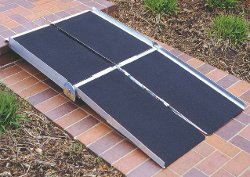When you purchase a wheelchair accessible van, one of the most critical decisions to be made is the type of ramp, and whether the ramp is deployed manually or with power. Van ramps are installed either on the rear or side-entry doors, and both powered and manual ramps work in those locations. A van is an investment that should work effectively in most, if not all situations, and it should efficiently reflect the needs of its owner.
Powered ramps are the more expensive choice, although for many the option for powered ramp deployment is a necessity. Powered infloor ramps (Some infloor ramp styles are not operated with power) can be easily stowed. A ramp that isn’t stowed in the floor will block a doorway and limit access for other passengers. And infloor ramps that are manual are deployed by the caregiver, making the powered option much more popular given the limitations of manual deployment. An infloor ramp does require more upkeep and cleaning, because it is possible for debris and dirt to accumulate in the track.
A popular version of the wheelchair accessible van is a van with both a powered, infloor ramp and a powered sliding door. The ramp and door can be deployed simultaneously with the flick of a switch. It sounds obvious, but the limitations to a manually-operated ramp is that a caregiver will have to exit the vehicle, open the door, and deploy the ramp before the wheelchair user can exit the vehicle.
When you decide to purchase a wheelchair accessible van it’s absolutely important to come in to G and J Enterprises and discover the options that are best-suited to your needs, or the needs of someone you care for. If you have any questions about wheelchair accessible vans, or any of the other devices and products offered, then call G and J Enterprise today.

